Er-doped superfluorescent fiber source with enhanced mean wavelength stability
a superfluorescent fiber and mean wavelength stability technology, applied in the field of laser light, can solve the problems of difficult to stabilize the various parameters on which the mean wavelength of an sfs is based, and the prior art does not report an sfs with a sufficient mean wavelength stability for high-precision applications, so as to reduce the influence of the pump wavelength and stabilize the mean wavelength
- Summary
- Abstract
- Description
- Claims
- Application Information
AI Technical Summary
Benefits of technology
Problems solved by technology
Method used
Image
Examples
first exemplary embodiment
[0052]The following exemplary embodiment illustrates the correlation of the estimated mean wavelength E> with the actual mean wavelength A> for an embodiment in which no attempts were made to control the ambient temperature or the temperature of the SFS 10. The SFS 10 was placed on an optical table, and an optical spectrum analyzer (OSA) was used to record the output spectrum of the SFS 10 (and hence the actual mean wavelength A>) every 19 seconds for 50 hours. The OSA used was Model No. A6327B, manufactured by Ando Electric Co., Ltd. of Kawasaki, Kanagawa, Japan. The ambient temperature was measured and the estimated mean wavelength E> was calculated.
[0053]FIG. 3 is a plot of the measured actual mean wavelength A> and the measured ambient temperature T as functions of time during the 50-hour run. In certain embodiments, the temperature TEDF of the EDF 20 is assumed to be approximately equal to the measured ambient temperature T. The measured ambient temperature T, and hence the mea...
second exemplary embodiment
[0063]The first exemplary embodiment described above illustrates that after correction of temperature variations of the EDF 20, the SFS mean wavelength is stable to within approximately ±2 ppm. The first exemplary embodiment does not provide information regarding the stability of the SFS mean wavelength if the temperature of the SFS 10 were controlled to be stable. In embodiments in which the temperature of the SFS 10 is controlled to be stable, the stability of the SFS mean wavelength would likely be better than approximately ±2 ppm, since stabilizing the temperature of the SFS 10 would not only eliminate the thermal drift of the EDF 20, but other thermal effects as well (e.g., fiber birefringence drifts and the corresponding residual polarization-related effects).
[0064]The following exemplary embodiment illustrates the correlation of the estimated mean wavelength E> with the actual mean wavelength A> for an embodiment in which the temperature of the SFS 10 was kept relatively s...
PUM
 Login to View More
Login to View More Abstract
Description
Claims
Application Information
 Login to View More
Login to View More - R&D
- Intellectual Property
- Life Sciences
- Materials
- Tech Scout
- Unparalleled Data Quality
- Higher Quality Content
- 60% Fewer Hallucinations
Browse by: Latest US Patents, China's latest patents, Technical Efficacy Thesaurus, Application Domain, Technology Topic, Popular Technical Reports.
© 2025 PatSnap. All rights reserved.Legal|Privacy policy|Modern Slavery Act Transparency Statement|Sitemap|About US| Contact US: help@patsnap.com



